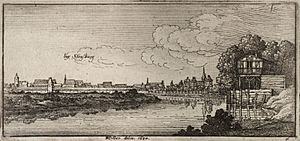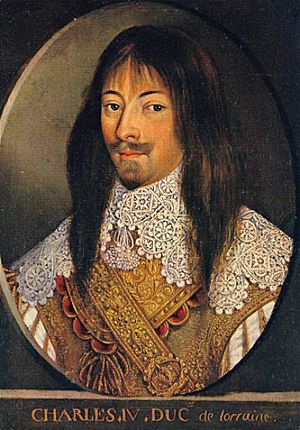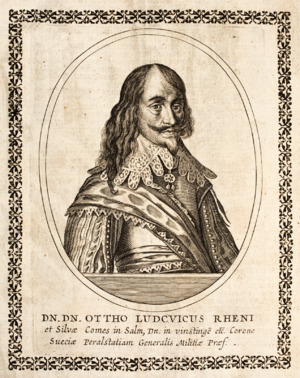Battle of Strasbourg Bridge facts for kids
Quick facts for kids Battle of Strasbourg Bridge |
|||||||
|---|---|---|---|---|---|---|---|
| Part of the Thirty Years' War | |||||||
 The Rhine river with Strasbourg in distance during the 17th century, by Wenceslaus Hollar |
|||||||
|
|||||||
| Belligerents | |||||||
Heilbronn League |
|||||||
| Commanders and leaders | |||||||
| Strength | |||||||
| 6,000–7,000 | 3,000 cavalry 1,500–2,000 infantry |
||||||
| Casualties and losses | |||||||
| 300–2,000 | Unknown | ||||||
The Battle of Strasbourg Bridge was a fight during the Thirty Years' War. It happened near the city of Strasbourg in September 1634. After a big loss at the Battle of Nördlingen, the Swedish army and its allies were in trouble. Armies from the Emperor, Spain, and the Catholic League took over much of southern Germany.
Because of this, the Swedish commander, Rheingrave Otto Louis, decided to pull his army back. He planned to cross the Rhine river using the Strasbourg bridge. But the Emperor's army, led by Duke Charles IV of Lorraine and General Johann von Werth, caught up. They attacked Otto's rearguard near Willstätt. Otto barely escaped being captured.
The Imperial forces then attacked the defenses near the Strasbourg bridge in Kehl. This was happening while the Swedish army was still crossing the Rhine. The battle lasted for three hours and ended with fighting on the bridge itself. Many Swedish soldiers were killed or captured. Rheingrave Otto and most of his forces managed to get safely into Strasbourg.
What Led to the Battle
In March 1634, a small Swedish army under Otto Louis took over most of Upper Alsace. This area was controlled by the Habsburgs, a powerful European family. Otto Louis also captured Freiburg im Breisgau. He then started to surround Rheinfelden.
The main Swedish commander, Gustav Horn, told Otto Louis to focus on Spanish troops arriving. But Otto Louis stayed near the Rhine river. He arrived too late to help in the big Battle of Nördlingen. At Nördlingen, the main Swedish army in Germany was badly beaten. Its commander, Horn, was captured.
After this huge defeat, the Catholic armies split up. They moved into lands that the Swedish army or its German allies held. Duke Charles IV of Lorraine and his general Johann von Werth invaded the duchy of Württemberg. This was a rich area where their troops could rest and get supplies.
The Emperor wanted Charles of Lorraine to push the Swedes out of their remaining strongholds. Lorraine's advance troops under Werth met Otto Louis's rearguard. They defeated them at Calw, taking some cannons and flags. Otto Louis escaped to Offenburg to gather his troops again.
Otto Louis heard that the Imperial army was coming closer. So, he marched his troops to the Strasbourg bridge to cross the Rhine. He had about 6,000 to 7,000 soldiers. These included troops from the Duke of Württemberg and the Margrave of Baden-Durlach. French help was expected, but it arrived too late. To stop the Swedes from crossing, Werth led about 3,000 cavalry and 1,500 to 2,000 infantry.
The Battle Begins
On September 27 or 28, Werth's troops met the Swedish rearguard. This happened in the village of Willstätt, between Offenburg and the Rhine river. Most of the Swedish army was already in Kehl, getting ready to cross.
Otto Louis rode out with 15 companions to lead his rearguard. He accidentally ran into some Bavarian soldiers. They thought he was one of their own officers. When he jumped into the Kinzig stream to escape, they realized their mistake and shot at him. He only got a small wound. The village of Willstätt was burned during this fight.
Otto Louis made his way back to Kehl. There, his troops had built defenses to protect the crossing. He sent his family ahead to Strasbourg. When Charles of Lorraine arrived, he ordered an attack on these defenses. The Imperial army won after three hours of fighting.
Historians say at least 300 Swedes were killed. Many died on the bridge as the crossing turned into a panicked escape. The Imperial forces claimed that 1,000 Swedes died in the defenses. Hundreds more drowned in the Rhine or burned in a farm that caught fire. They believed up to 2,000 Swedes did not survive the battle. However, Rheingrave Otto and most of his army made it safely across the bridge to Strasbourg.
Charles of Lorraine sent a letter to Strasbourg's city leaders. He asked them to open the city gates, but they said no. Otto Louis, still controlling the west bank of the Rhine, quickly moved his troops to Seltz. The Catholic forces then moved to Rastatt.
After the Battle
After this battle, Sweden and the Heilbronn League quickly removed their soldiers from the Rhineland. Under a deal called the Treaty of Paris, the Swedes gave their forts and cities in Alsace to France. They did this to stop the Imperial forces from taking control of the area.
The Elector of Saxony started talks with Emperor Ferdinand II. But other leaders, like the Landgrave of Hesse-Kassel and the Duke of Lüneburg, still fought against the Emperor.
Meanwhile, the Imperial armies were in central Germany. They took Heilbronn on September 27, the same day as the Battle of Strasbourg Bridge. Since the Battle of Nördlingen, the Catholic forces had pushed the Swedes and their German allies out of many regions. This included most of Bavaria, Swabia, Württemberg, and Franconia. One official said they were "expelling him [the Swedish] from the roots of the Alps".



